A Master Data Management solution provides organizations with the means to address complex customer and supplier data challenges and improve their overall experience.
Improving Customer Experience
Customer experience is the holistic journey of a customer that begins the moment they first become aware of a product and continues until the customer is building their own loyalty platform with a product.
This documentation is focused on providing guidance to improve an organization's customer data so informed decisions can improve customer experience.
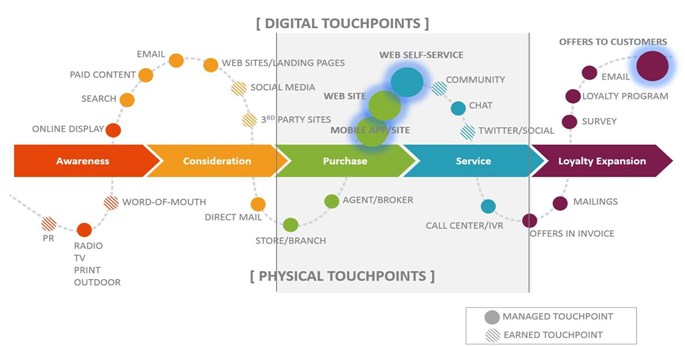
Data Management Challenges
Organizations are faced with the following primary challenges when managing customer data:
- Data Quality - Data quality issues typically arise when attempting to house and manage customer data across multiple platforms. Doing so often leads to inaccurate, duplicated, and incomplete data.
- Operational Inefficiencies - Operational inefficiencies can be characterized by an organization's inability to share accurate and up-to-date data across the business, severely impacting downstream systems, processes, and initiatives. For example, some of these inefficiencies can lead to: returned mail, increased costs, payment delays, and unacceptable response time.
- Reactive Strategic Decisions - Many organizations struggle to achieve their Customer Relationship Management (CRM) vision. Considering its impact on an organization's success, a concrete CRM strategy is a high concern for business and IT leaders. Bad data is the most common reason many CRM initiatives fail.
- Governance - The most important part of data governance is to consider the availability, usability, integrity, and security of data within an organization. Poor data governance can lead to financial, reputation, and legal risks.
Supplier Data Management Challenges
A Supplier Master Data Management solution provides an organization with the means to address and solve for complex industry challenges when it comes to managing their supplier information to drive the business forward.
-
Supplier Onboarding - The inability to capture vital and relevant supplier data at the point of data entry causes inefficient management of overall supplier onboarding and management processes, which leads to slow-time-to- market.
-
Single Supplier View - Without a consolidated, complete, and trusted view of an organization’s suppliers, organizations lack the ability to efficiently manage their suppliers across various aspects of the business. Additionally, organizations struggle to validate key supplier information and lack the in-depth insights which makes data more actionable.
-
Hierarchies - Organizations often lack the ability to visualize and understand the various relationships their suppliers hold today. Hence, it is difficult to identify strategic supplier and organizations are unable to negotiate better pricing and payment terms and miss out on key business opportunities.
-
Data Quality - As the number of suppliers an organization transacts with grows, data quality suffers because duplicate data increases, supplier performance assessments cannot be performed, overall supplier data cannot be trusted, and all contributes to a lack of transparency to the supply chain.
-
Governance - The lack of data governance capabilities prevents an organization to standardize and introduce a proactive approach to supplier data governance. This limits the control of supplier risk, reduces the trusted visibility of compliance, and negatively impacts the capability to quickly reach to change.
Implementation Methodologies
MDM allows the following paths to implementation: Centralized, Coexistence, Registry, and Consolidation.
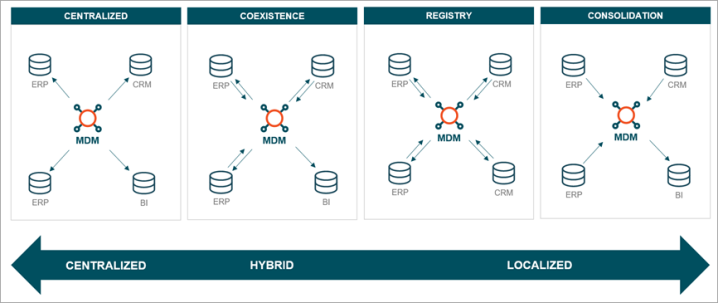
This implementation guide focuses on a case that implements data management with the consolidation, coexistence, and centralized methodologies.
Consolidation Implementation
This methodology refers to an implementation where MDM is a hub for externally provided data that is funneled into single golden records, which are then made available to external systems. These records are created via matching and merging operations with validation checks throughout the process. The MDM data created from this process is read-only, which is often a necessity as the data originates outside of MDM in an upstream system. A consolidation style implementation does not synchronize data back to the contributing systems.
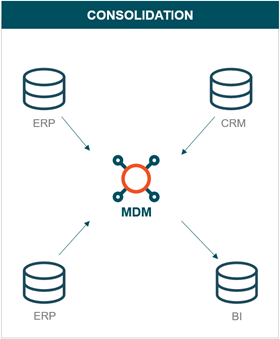
For example, a company wants to combine all of their sales channel data into one record bank so that data analytics may provide meaningful information. Once all these records are consolidated, marketing initiatives can use this information to target different channels as well as different regions.
Coexistence Implementation
This methodology refers to a scenario where multiple databases containing the master data must operate at the same time. The party data is authored and stored in various external sources while being synchronized to MDM. This process involves deduplication, conflict resolution, and validation operations, resulting in the creation of golden records. Finally, updates to the data can be done in the source system and any external systems that master customer data. MDM synchronizes the content of golden records back to the source systems, keeping every source up to date with data contributed from any source. This allows for a hybrid where data authoring may happen in the source system as well as in the MDM system.
A common situation for coexistence is in companies where each department has their own customer database.
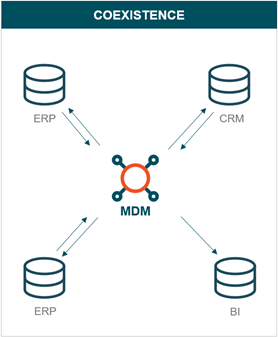
For example, a service department that has data on customers is stored in a separate database than where customer data is stored for the sales and marketing departments. However, using an MDM solution with the coexistence model, if information is changed in the marketing department, it is changed in all other departments.
Registry Implementation
The registry method uses a simple database to reconcile identifiers for all party data across the enterprise. This method allows MDM to serve as a referenced, read-only source of mastered customer data for external systems with minimal data redundancy. MDM will only match on the bare minimum of needed data to confirm a unique record. All externally maintained data quality is the responsibility of the source systems.
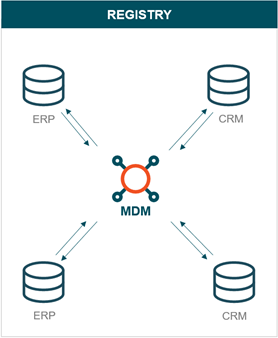
For example, a company maintains different types of customer information across various external systems. A registry is used to identify and associate these different types of customer data with external systems. MDM serves as this registry by storing unique records with identifiers that are different from one external system to the next. MDM will ONLY store these records and unique record identifiers, and deduplicate their contact information.
Centralized Implementation
The centralized implementation is based around a well-managed and governed central repository for all master data. This repository holds a set of golden records that are read-only by the operational and analytical systems throughout the enterprise. MDM is the centralized owner of party data, serving as the system of record. This system of record is an organization’s single version of truth for customer data. Data is not only centralized in MDM but also created and stored there. The most important aspect of a centralized implementation is that it is a system of record instead of a system of reference.
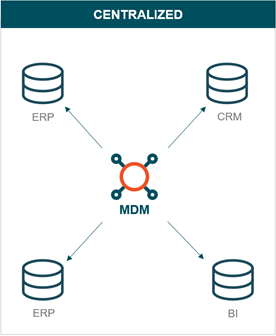
For example, a company wants to use MDM as the system of record for onboarding, deduplicating, and enriching new suppliers. Over time, MDM could remove duplicate records of these suppliers and then the golden supplier records could be provided to external systems.